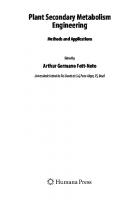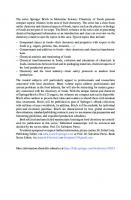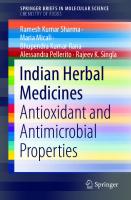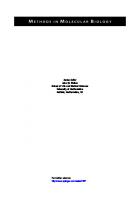Uranium and Plant Metabolism: Measurement and Application (SpringerBriefs in Molecular Science) 3030808149, 9783030808143
This book explores the uranium uptake by plants and its impact on plant physiology and biochemistry. In the first part o
147 54
English Pages 62 [60] Year 2021
Acknowledgements
Contents
1 Introduction
References
2 Modern Methods of Uranium Detection
2.1 Laser-Induced Spectroscopy
2.1.1 Laser-Induced Photoacoustic Spectroscopy (LIPAS)
2.1.2 Time-Resolved Laser-Induced Fluorescence Spectroscopy (TRLIFS)
2.2 XANES/EXAFS
References
3 Chemistry of Uranium
References
4 Uranium and Relevant Bioligands
References
5 Uranium Uptake, Storage and Metabolism by Plants
References
6 Outlook
References
Recommend Papers

- Author / Uploaded
- Gerhard Geipel
File loading please wait...
Citation preview
SPRINGER BRIEFS IN MOLECULAR SCIENCE BIOMETALS
Gerhard Geipel
Uranium and Plant Metabolism Measurement and Application 123
SpringerBriefs in Molecular Science
SpringerBriefs in Biometals
More information about this subseries at http://www.springer.com/series/10046
Gerhard Geipel
Uranium and Plant Metabolism Measurement and Application
Gerhard Geipel Institute of Resource Ecology Helmholtz-Zentrum Dresden-Rossendorf Dresden, Sachsen, Germany
ISSN 2191-5407 ISSN 2191-5415 (electronic) SpringerBriefs in Molecular Science ISSN 2212-9901 ISSN 2542-467X (electronic) SpringerBriefs in Biometals ISBN 978-3-030-80814-3 ISBN 978-3-030-80815-0 (eBook) https://doi.org/10.1007/978-3-030-80815-0 © The Author(s), under exclusive licence to Springer Nature Switzerland AG 2021 This work is subject to copyright. All rights are reserved by the Publisher, whether the whole or part of the material is concerned, specifically the rights of translation, reprinting, reuse of illustrations, recitation, broadcasting, reproduction on microfilms or in any other physical way, and transmission or information storage and retrieval, electronic adaptation, computer software, or by similar or dissimilar methodology now known or hereafter developed. The use of general descriptive names, registered names, trademarks, service marks, etc. in this publication does not imply, even in the absence of a specific statement, that such names are exempt from the relevant protective laws and regulations and therefore free for general use. The publisher, the authors and the editors are safe to assume that the advice and information in this book are believed to be true and accurate at the date of publication. Neither the publisher nor the authors or the editors give a warranty, expressed or implied, with respect to the material contained herein or for any errors or omissions that may have been made. The publisher remains neutral with regard to jurisdictional claims in published maps and institutional affiliations. This Springer imprint is published by the registered company Springer Nature Switzerland AG The registered company address is: Gewerbestrasse 11, 6330 Cham, Switzerland
Acknowledgements
The author would like to thank actual and former co-workers for their help. Special thanks to K. Viehweger, S. Sachs, G. Grambole, J. Seibt, and S. Heller. The author would especially like to thank L Barton for his assistance during the preparation of the final manuscript.
v
Contents
1 Introduction . . . . . . . . . . . . . . . . . . . . . . . . . . . . . . . . . . . . . . . . . . . . . . . . . . . . References . . . . . . . . . . . . . . . . . . . . . . . . . . . . . . . . . . . . . . . . . . . . . . . . . . . . . .
1 4
2 Modern Methods of Uranium Detection . . . . . . . . . . . . . . . . . . . . . . . . . . . 5 2.1 Laser-Induced Spectroscopy . . . . . . . . . . . . . . . . . . . . . . . . . . . . . . . . . . 5 2.1.1 Laser-Induced Photoacoustic Spectroscopy (LIPAS) . . . . . . . 6 2.1.2 Time-Resolved Laser-Induced Fluorescence Spectroscopy (TRLIFS) . . . . . . . . . . . . . . . . . . . . . . . . . . . . . . . . 9 2.2 XANES/EXAFS . . . . . . . . . . . . . . . . . . . . . . . . . . . . . . . . . . . . . . . . . . . . 12 References . . . . . . . . . . . . . . . . . . . . . . . . . . . . . . . . . . . . . . . . . . . . . . . . . . . . . . 12 3 Chemistry of Uranium . . . . . . . . . . . . . . . . . . . . . . . . . . . . . . . . . . . . . . . . . . . 15 References . . . . . . . . . . . . . . . . . . . . . . . . . . . . . . . . . . . . . . . . . . . . . . . . . . . . . . 27 4 Uranium and Relevant Bioligands . . . . . . . . . . . . . . . . . . . . . . . . . . . . . . . . 31 References . . . . . . . . . . . . . . . . . . . . . . . . . . . . . . . . . . . . . . . . . . . . . . . . . . . . . . 32 5 Uranium Uptake, Storage and Metabolism by Plants . . . . . . . . . . . . . . . 33 References . . . . . . . . . . . . . . . . . . . . . . . . . . . . . . . . . . . . . . . . . . . . . . . . . . . . . . 50 6 Outlook . . . . . . . . . . . . . . . . . . . . . . . . . . . . . . . . . . . . . . . . . . . . . . . . . . . . . . . . 53 References . . . . . . . . . . . . . . . . . . . . . . . . . . . . . . . . . . . . . . . . . . . . . . . . . . . . . . 55
vii
Chapter 1
Introduction
Elements with atomic numbers >89 are named actinides or, in the case of atomic numbers >103, transactinides. All isotopes of these elements are unstable due to radioactive decay. The elements of the actinide series fill the 5f shell, meaning that their electron configuration commonly follows [Rn]5f1−14 6d1 7s2 . There are two important exceptions: Thorium has the configuration [Rn]5f0 6d2 7s2 which rationalises its tetra valence. Berkelium has an electron configuration [Rn]5f9 6d0 7s2 and so favors oxidation state +2. The restricted availability of the actinides with atomic numbers higher than 97 (Berkelium) plus their short half-life result in a relatively low interest in these elements in environmental research. The uranium element belongs the actinide series. According to its place in the periodic table, uranium is a member of the lower actinides. Actinides are distinguished into naturally-occurring and synthetic elements. A sharp line between synthetic and naturally occurring elements cannot be drawn. Synthetic uranium isotopes are produced by human activities in using and testing nuclear power and nuclear weapons. In smaller degree due to natural nuclear reactors in the Proterozoic era, plutonium is among non-synthetic elements. Therefore, thorium, protactinium, uranium and, in much smaller amounts, plutonium occur under natural conditions. All other actinides including neptunium are synthetic elements. The actinide elements uranium, neptunium, plutonium as well as americium show different oxidation states. Due to this property, these elements show redox reactions and this may be of great significance in biological systems. All actinides are non-essential elements. They are radioactive and show decay properties and are heavy metals. Therefore, actinides are counting among high hazardous elements. The natural occurring elements uranium, thorium are mother nuclides of decay series. The transuranium elements neptunium, plutonium, americium and curium were mainly generated in nuclear power stations: Therefore, all these elements have to be considered in nuclear waste management and nuclear accidents.
© The Author(s), under exclusive licence to Springer Nature Switzerland AG 2021 G. Geipel, Uranium and Plant Metabolism, SpringerBriefs in Biometals, https://doi.org/10.1007/978-3-030-80815-0_1
1
2
1 Introduction
The toxicity of an element depends strongly on its chemical speciation. This influences also the bioavailability of these elements. In case of uranium, its toxicity decreases in the series: uranyl phosphates > uranyl citrates > uranyl carbonates. Knowledge about the speciation of actinides under different natural conditions is therefore of great importance. Uranium, americium and curium show luminescence properties. Most studies, using this property, been performed with uranium. Two reasons for this should be named. Uranium is the last element in the periodic table occurring naturally in higher amounts and therefore available in higher amounts for chemical and biological experiments in the laboratory. On the other hand, the amount of uranium needed for luminescence experiments can be handled somewhat easier other actinides. This is due to their high specific radioactivity of these elements and special equipment for safety and radiation protection, like glove boxes, has to be installed. For example, americium has strong gamma emission, which can require additionally lead shielding of the experiment. Radioelements, like neptunium, plutonium, americium and curium are much less studied than others. This is due to the difficult handling of the radioelements. They are all α-emitting radionuclides. Special equipment in the laboratories is necessary as well as regulations of radiation protection have to be considered. Within the food chain, plants play a very important part. Knowledge about the speciation and the metabolism of actinides in the several plant cells may help to avoid the uptake of these elements and generate hazards to living organism and point ways to protect living beings. Up to now knowledge about actinide speciation in organisms including plants is very rare. Many publications up to now deal only with so-called transfer factors. Some publications show that phosphate species often play an important role. On the other hand, during the uptake intermediates of other binding forms may become important. The hazardous potential of these actinide species may be estimated if information about their binding forms especially in storage compartments inside the plant cells is available. The luminescence properties of the named elements can be used for the determination of the binding forms. The most impact actinides in biological systems is connected to the release of radioactive elements in nuclear accidents as Chernobyl and Fukushima. Also, scenarios which are seen in the discussion of radioactive waste storage play an important role. Microorganism are the first organism which may have contact to actinides in radioactive waste storage sites. After transport to the earth surface these radionuclides may also access the food chain via several ways of uptake. Among these is also the uptake of actinides by plants. However, it depends strongly on the bioavailability of these elements and thereby on the speciation. The speciation may also change during and after the uptake.
1 Introduction
3
Table 1.1 Actinide isotopes with the longest half-life and oxidation states Atomic number
Element symbol
Isotope
Half life
Main emitter
Oxidation states
89
Ac
227
21.7y
β−
+3
90
Th
232
14E09y
α
+4
91
Pa
231
32,500y
β−
+3; +4; +5;
92
U
238
4.4E09y
α
+3; +4; +5; +6
93
Np
237
2.14E06y
α
+3; +4; +5; +6; +7
94
Pu
244
81E06y
α
+2; +3; +4; +5; + 6; +7
95
Am
243
7340y
α
+2; +3; +4; +5; + 6
96
Cm
247
15.6E06y
α
+2; +3; +4
97
Bk
247
1400y
α
+2; +3; +4
98
Cf
251
900y
α
99
Es
252
472d
α;
100
Fm
257
100.5d
α
101
Md
258
51.5d
α
102
No
259
58 min
α;
103
Lw
262
3.6 h
β+
+2; +3; +4 β+
+2; +3; +4 +2; +3; +4 +2; +3
β+
+2; +3; +4 +3
(Main oxidation state in bold and italic face)
A broad review about actinides in biological systems, especially in animals and man is given by P.W. Durbin in “The Chemistry of Actinide and Transactinide Elements” [1]. It serves as an excellent source of work published before 2005. An introduction in the uptake of radionuclides by plants has been given by Greger [2]. Besides the description of common uptake mechanisms only little information about actinides is given. An overview about soil to plant transfer is given by Robertson et al. [3]. The factors vary very strong depending on plant species, soil and experimental conditions, but compared to Sr isotopes the values for actinides are smaller. To give an insight to the actinides chemistry all actinides in their most stable with half-life, radioactive decay and main oxidation states are summarized in Table 1.1. Several actinides show luminescence properties which enable their study by emission spectroscopic methods. Besides uranium, which is luminescent in all environmentally relevant oxidation states, americium and curium, especially, can be determined by time-resolved laser-induced fluorescence spectroscopy. Measurement of luminescence lifetimes of species of these two elements enables determination of their hydration number [4]. The wide-ranging isotopic variety of actinides can be appreciated in the nuclide table. The most stable nuclides which may be relevant to biological systems are summarized in Table 1.1. More details may be found in special nuclide charts [5, 6].
4
1 Introduction
The availability of transuranium elements in marine environments was surveyed by P. Scoppa in 1984 [7]. It was estimated that, by the year 2000, about 288 metric tons of man-made transuranium elements had arrived in marine environments [8]. The highest amount should be 237 Np (~194 tons or about 68%) followed by 243 Am (38.9 tons or 13.6%). Radionuclide concentrations of some actinides have been measured in benthic invertebrates (rock jingle, blue mussel and horse mussel) in the islands of the Aleutian Chain [8]. The highest levels detected were for 234 U (0.45–0.84 Bq/kg wet weight). The concentrations are slightly smaller for 238 U whereas those for 241 Am, 239,240 Pu and 235 U are about one order of magnitude lower. The concentration was close to the detection limit for 236 U. The presence of isotopes 241 Am, 239,240 Pu and 236 U are due to human activities in the environment. Several studies deal with the rapid determination of actinides in different samples, mainly human urine. By the use of inductively coupled mass spectrometry and alpha spectrometry in combination with a rapid separation technique, nearly all actinide isotopes can be determined in a relatively short period of time [9, 10].
References 1. Durbin PW (2006) In: Morss LR, Edelstein NM, Fuger J (eds) The chemistry of actinide and transactinide elements, 3rd edn, vol 5, Springer New York 3339–3440 2. Greger M (2004) Uptake of nuclides by plants. SKB Technical report TR-04-14, Stockholm 3. Robertson DE, Cataldo DA, Napier BA (2003) Literature review and assessment of plant and animal transfer factors used in performance assessment modeling, NUREG/CR-6825 PNNL14321 4. Collins RN, Saito T, Aoyagi N, Payne TE, Kimura T, Waite TD (2011) Applications of timeresolved laser fluorescence spectroscopy to the environmental biogeochemistry of actinides. J Env Qual 50:731–741 5. Pfennig G, Klewe-Nebenius H, Seelmann-Eggebert W (1998) Karlsruher Nuklidkarte, Forschungszentrum Karlsruhe 6. www.nndc.bnl.gov/nudat2/ 7. Scoppa P (1984) Environmental behavior of trans-uranium actinides - availability to marine biota. Inorg Chim Acta 95:23–27 8. Burger J, Gochfeld M, Jeitner C, Gray M, Shukla T, Shukla S, Burke S (2007) Radionuclide concentrations in benthic invertebrates from amchitka and kiska islands in the Aleutian Chain. Alaska Environ Monit Assess 128:329–341 9. Maxwell SL (2008) Rapid analysis of emergency urine and water samples. J Radioanal Nucl Chem 275:497–502 10. Maxwell SL, Jones VD (2009) Rapid determination of actinides in urine by inductively coupled plasma mass spectrometry and alpha spectrometry: a hybrid approach. Talanta 80:143–150
Chapter 2
Modern Methods of Uranium Detection
To determine uranium several methods are applicable. The total uranium content may mostly determined by ICP-MS measurements. Of more interest are methods, which allow to assign the uranium speciation in the environment under investigation. Normal UV–Vis measurements have detection limits above environmental concentrations ranges. Therefore, mostly methods with high intense light sources are used to determine uranium speciation under these conditions. Other methods which have great potential for biosystems are under development. As example the secondary neutral ionisation SIMS should be named.
2.1 Laser-Induced Spectroscopy Laser-induced spectroscopic methods decrease the detection limits up to 5–7 orders of magnitude, depending on the method of detection and on spectroscopic properties of the studied element. By use of common UV–Vis measurements uranium(VI) can be measured up to about 10–2 M solutions (without special colouring reagents). Laser induced absorption spectroscopy (so-called Laser-induced photoacoustic spectroscopy, LIPAS) reaches already detection limits of 10–5 M. Last not least for uranium also luminescence properties can be used for the proof of this element, reaching in special cases (Cryo-TRLFS, carbonate complexes) detection limits of 2 × 10–10 M. The principal fundamental processes in a sample after application of a laser pulse are shown in Fig. 2.1. In the field of laser-induced spectroscopy five main methods are used: laserinduced photo- acoustic Spectroscopy (LIPAS), Thermal lensing spectroscopy (TLS), laser-induced time-resolved fluorescence spectroscopy (TRLIFS), Ultra-short laser pulse-induced time-resolved fluorescence spectroscopy (fs-TRLIFS), laserinduced breakdown detection and spectroscopy (LIBD/LIBS). All of these methods have been intensively developed during the last decades [1–9]. They became powerful tools to study interactions in solutions and at the solid–liquid interface. LIBD/LIBS © The Author(s), under exclusive licence to Springer Nature Switzerland AG 2021 G. Geipel, Uranium and Plant Metabolism, SpringerBriefs in Biometals, https://doi.org/10.1007/978-3-030-80815-0_2
5
6
2 Modern Methods of Uranium Detection
Fig. 2.1. Principal processes after laser excitation
concerns especially studies in colloidal systems. This theme should be the aim of another contribution especially under the point of view that the sample will we changed due to the destruction of particles. Therefore, it would be pardonable that LIBD is not treated here. Main field in speciation techniques using lasers are lanthanide and actinide chemistry. While lanthanide often have been used as probe system for energy transfer studies in biochemistry and organic chemistry, the speciation studies of actinides focus directly on the behavior of these elements, especially in environmental systems as uranium mining areas and waste disposal sites. The possibility of two photon excitation has been offered with reason of the development of pico-second pulse and femto-second pulse lasers. Especially for sensitive organic and biologic samples this provides opportunities for mild excitation [10]. All laser induced methods need a computer system for controlling the experiment and for data storage. For fluorescence measurements commercial program codes are available.
2.1.1 Laser-Induced Photoacoustic Spectroscopy (LIPAS) Photoacoustic spectroscopy employs the so-called photoacoustic effect discovered by G. Bell already in 1880. It employs the generation of sound by absorption of modulated light. The modulated light can be generated in two ways:
2.1 Laser-Induced Spectroscopy
7
• a cw beam is chopped typically with 10–1000 Hz or • a pulsed light beam with a duration




![Molecular Aspects of Iron Metabolism in Pathogenic and Symbiotic Plant-Microbe Associations [1 ed.]
9400752660, 9789400752665](https://ebin.pub/img/200x200/molecular-aspects-of-iron-metabolism-in-pathogenic-and-symbiotic-plant-microbe-associations-1nbsped-9400752660-9789400752665.jpg)

![Plant Metabolism and Biotechnology [1 ed.]
047074703X, 9780470747032](https://ebin.pub/img/200x200/plant-metabolism-and-biotechnology-1nbsped-047074703x-9780470747032.jpg)


